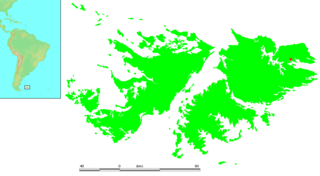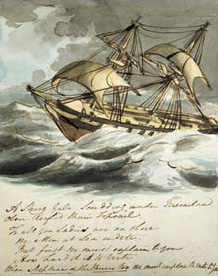
James Weddell was a British sailor, navigator and seal hunter who in February 1823 sailed to latitude of 74° 15′ S—a record 7.69 degrees or 532 statute miles south of the Antarctic Circle—and into a region of the Southern Ocean that later became known as the Weddell Sea.

Port Louis is a settlement on northeastern East Falkland. It was established by Louis de Bougainville on 5 April 1764 as the first French settlement on the islands, but was then transferred to Spain in 1767 and renamed Puerto Soledad.

The second USS Lexington was a sloop in the United States Navy built at the New York Navy Yard in Brooklyn, New York, in 1825; and commissioned on 11 June 1826, Master Commandant William B. Shubrick in command.

In December 1832, two naval vessels were sent by the United Kingdom to re-assert British sovereignty over the Falkland Islands, after the United Provinces of the Rio de la Plata ignored British diplomatic protests over the appointment of Luis Vernet as governor of the Falkland Islands and a dispute over fishing rights.

HMS Grasshopper was a Royal Navy 18-gun Cruizer-class brig-sloop built at Portsmouth Dockyard by Nicholas Diddams and launched in 1813. She was the second ship of the class to bear the name; the first Grasshopper had been stranded at Texel and surrendered to the Batavian Republic on Christmas Day 1811. The present Grasshopper remained in service until sold in 1832. She then became a whaler in the Southern Whale Fisheries, making four voyages between 1832 and 1847.
Roslin Castle was a barque of 450 tons built in 1819 at Bristol. She was a merchant ship that also made five voyages transporting convicts to Australia. Described as a single decker, her hull was sheathed in copper in 1823 and was sheathed in patent felt and copper over-boards in 1828. She later served as a whaling vessel out of Sydney, Australia.
Matthew Brisbane was a Scottish mariner, sealer and notable figure in the early history of the Falkland Islands.
Asia was a merchant ship built by A. Hall & Company at Aberdeen in 1818. She made eight voyages between 1820 and 1836 transporting convicts from Britain to Australia. She made one voyage for the British East India Company (EIC) between 1826 and 1827. At the same time she served in private trade to India as a licensed ship. She also carried assisted emigrants to Australia. She was last listed in 1845.
Andromeda was built in Sunderland, England in 1819. Initially she made one voyage to India, sailing under a licence from the British East India Company. She then started sailing to Australia, carrying voluntary and involuntary migrants. She made four voyages transporting convicts: one voyage to Van Diemen's Land and three to New South Wales. She continue to trade, primarily to Australia. Her last voyage was to Ichaboe Island. She was last listed in 1847.
Hercules was built in 1822 at Whitby, England. She made three voyages to Australia transporting convicts to New South Wales. She also made two voyages under contract to the British East India Company (EIC). She was broken up in 1847.
Ann and Amelia was launched in 1816 at Chittagong. She was sold at Calcutta in August 1823 for a "Free Trader". She transported convicts from Britain to Port Jackson, New South Wales, in 1825. She then made three voyages for the British East India Company (EIC) and was lost in gale on the coast of France in 1835 as she was finishing her third voyage.
Emma was a merchant vessel launched at Calcutta in 1809 that served as a government armed ship in the British invasion of Île de France in 1810. In 1811 she sailed to England where she was sold. She then became a transport and later a whaler. Between 1815 and 1853 she made 11 whaling voyages. She was then sold and became a merchantman on the England-Australia run. Between 1851 and 1853 she made one more whaling voyage to the South Seas fisheries. She then returned to the England-Australia trade. In 1857 her home port became Hull, and she became a Greenland whaler, though that role may have begun as early as 1855. She was converted in 1864 to a screw steamer but was lost in April while seal hunting.
Competitor was launched at Whitby in 1813. She was initially a West Indiaman and then traded with India. She made two voyages transporting convicts to Australia, one to Van Diemen's Land and one to Port Jackson. She is last listed in 1833.
Barrosa was launched in 1811 at Cossipore. She sailed to England and then made six voyages for the British East India Company (EIC); during this period she also made one voyage carrying immigrants to South Africa. After the EIC gave up its maritime activities in 1833-1834, Barossa became a transport. She made three voyages transporting convicts to Australia. She was lost in 1847, without loss of life, while transporting contract labourers from Madras to Jamaica.
Regalia was launched at Sunderland in 1811. In 1819 she made a voyage to Calcutta, sailing under a license from the British East India Company (EIC). She also sailed to New South Wales and Van Diemen's Land. From Sydney she engaged in several sealing hunting voyages to the waters around Macquarie Island. In 1826 she transported convicts from Dublin to New South Wales. From 1831 until 1852, when she was wrecked at Davis Strait, Regalia was a whaler in the northern whale fishery.
Vansittart was launched at New York in 1807, under another name. She was captured c.1814 and new owners gave her the name Vansittart. She was initially a West Indiaman. Then between 1817 and 1837 she made seven voyages as a whaler in the British Southern Whale Fisheries. Thereafter she was a merchantman sailing out of Shields. She foundered on 2 February 1855.

Jane was an American vessel launched in 1810 or 1812 and taken in prize, first appearing in British registers in 1818. She then became a whaler. Under the command of Captain James Weddell she explored the area around the South Shetland Islands and in 1823 reached the southernmost point ever reached until then. From about 1825 on she traded generally as a merchantman until she was condemned in 1829.
Sir Charles Price was launched in America in 1812 under another name. The British captured her c.1814 and Daniel Bennett purchased her and added her to his fleet of whalers. She made six complete whaling voyages and was lost in 1833 on her seventh whaling voyage.
Prince Regent was launched at Blackwall in 1811. She made ten voyages for the British East India Company (EIC), between 1811 and 1834 to India and China. She made one more voyage to China after the end of the EIC's trading activities in 1833, and was broken up in 1838.
Cadmus was built in 1818 in New York. She was a packet sailing between New York and Havre. In 1824, Cadmus carried General Lafayette to New York on a visit at the invitation of the U.S. Congress. From 1827, Cadmus became a whaler, sailing from Sag Harbor, New York. She made 17 complete whaling voyages. During her whaling years Cadmus brought in oil and whale bone worth a total of $359,000. In 1849, a new owner sailed her to California so that he and his crew could take part in the gold rush there. They abandoned her in San Francisco, where she became a storehouse until she became too leaky; her bones were eventually buried under fill.





